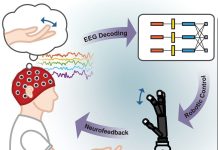
Once upon a time, creating art was something only humans could do. But now, thanks to some smart folks and their computers, even robots are starting to make their own art.
This story takes us to Madrid, Spain, where researchers have made a big leap in the world of robot artists.
In Madrid, two universities, Universidad Complutense de Madrid and Universidad Carlos III de Madrid, have a team of researchers who’ve done something pretty cool. They’ve taught a robot to draw pictures just like a person would.
Usually, robots that make art are a bit like fancy printers, just copying what a computer tells them. But this robot is different. It draws each line on its own, deciding where to move next, almost like it’s thinking.
The idea to make a robot artist came from a simple wish. The researchers wanted to do something that would surprise both scientists and everyday people. They thought, “What if a robot could make art?” And so, they started working on it.
Their robot doesn’t just spit out a complete drawing in one go. Instead, it uses something called deep reinforcement learning. This is a fancy way of saying the robot learns from its actions, getting better over time, much like a human artist who practices their craft.
The researchers, including a guy named Raúl Fernandez-Fernandez, didn’t set out to make the robot the next Picasso. Their goal was simpler. They wanted to build a robot that could really control how it makes each part of a drawing.
They were building on their past work, where they played around with algorithms that could help robots plan out their moves, making them more efficient and creative.
This robot artist project was inspired by a couple of things the team had worked on before. They had already looked into using a big collection of doodles (the Quick Draw! Dataset) to train their robot.
They also explored using a method called Deep-Q-Learning, which helps the robot decide on the best stroke to make next, considering how to express things like emotions in its drawings.
Deep-Q-Learning, the method they used, helps the robot think about its next move in three steps. It looks at the big picture, focuses on the details, and then decides where to put the next line.
This method is not entirely new but applying it to make a robot that can draw like a human was a big step forward.
So, what does all this mean? It shows us that robots can do more than just the heavy lifting or repetitive tasks; they can be creative, too.
The researchers in Madrid are not just making robots; they’re expanding the boundaries of what technology can do, blending the worlds of science, art, and creativity in exciting new ways.
This journey into robot-made art is just the beginning. As robots learn more and get better at understanding the world, who knows what kind of art they’ll create next?
Maybe one day, we’ll see a robot’s painting in a museum, and it’ll be hard to tell it wasn’t made by a human. For now, though, we can marvel at the fact that there’s a robot in Madrid learning to draw, line by line, just like us.
The research findings can be found in Cognitive Systems Research.
Copyright © 2024 Knowridge Science Report. All rights reserved.



